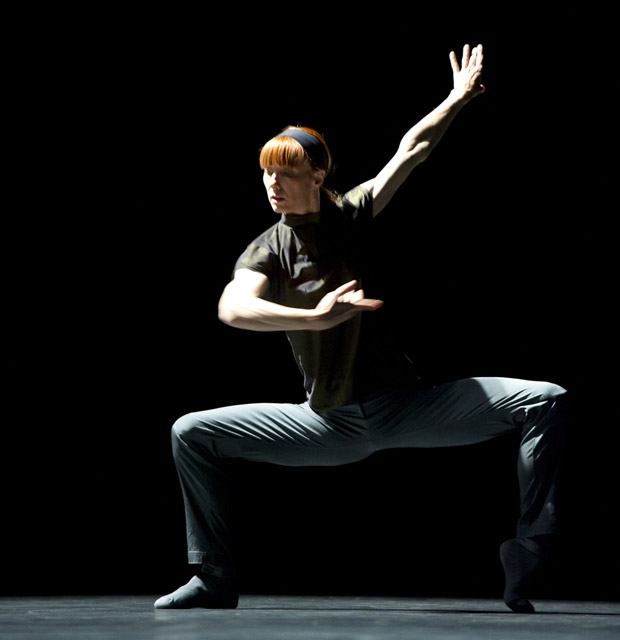
Sylvie Guillem
6000 Miles Away: Rearray, 27’52”, Bye
New York, Koch Theatre
4 April 2012
www.sylvieguillem.com
Last week (April 4-7), Sylvie Guillem presented an evening of dances, 6000 Miles Away, at the Koch Theatre, co-produced by Sadler’s Wells and several other European entities. Best to be upfront: I wasn’t a fan of her last appearance in New York, in Russell Maliphant’s Push. Her dancing leaves me rather cold (both live and in the many videos that exist). Which is not to say I don’t admire her obvious, and manifold, talents. She’s strong, almost uncannily so – she can hold any position, no matter how extreme, with no sign of effort and for a very long time, even at the age of forty-seven. She is precise, like a sniper who shoots cleanly, with no collatoral damage; bam, and you know right where her foot is going and then there it is, exactly where she intended. The same goes for every other part of her body: waist, knee, shoulder, hip, little finger. Which leads me to yet another quality: her clarity. Like an actor with perfect diction, or a teacher with great didactic skills, she reveals every aspect of the choreography with absolute intelligibility. No flubbing, no exaggeration. Her physique is extraordinary, though not universally appealing: lean, long, almost stringy, gasp-inducingly flexible, articulated, without a hint of excess. She’s intelligent too; she is about as far from anyone’s notion of the mindless ballerina as you can possibly get. Every movement, every pause has a purpose. And despite all the talk of her “star-quality,” she does not project a personality on the steps. She’s objective, to a fault. Needless to say, she’s very, very good at what she does. But she’s dry.
Everyone knows the story. Born in Paris and trained as a gymnast, she switched to ballet at eleven (late for ballet), in 1976. (The program note by John Percival helpfully points out that “the teachers accepted her with delight, bowled over by her extraordinary physique, amazing feet, [and] tremendous jump.”) After just a few short years at the Paris Opera Ballet School (a training program that usually lasts closer to a decade), she was asked to join the company, and only three years later (at the age of nineteen), was promoted to the exalted position of Étoile by Rudolf Nureyev, then the artistic director. This was in the mid-eighties, when William Forsythe was taking Paris by storm. In the following years, Forsythe created several important roles for her (including a central part in his iconic and much-imitated In the Middle, Somewhat Elevated, which was largely inspired by her). So did Maurice Béjart, Carole Armitage, Robert Wilson, and Nureyev, who seems to have loved her and clashed with her with the passion of a father. According to Nureyev’s biographer, Julie Kavanagh, he kept a photo of her beside his bed and “freely admitted that he had never met any dancer who challenged him to such a degree.” In addition, Guillem tore through the classical and neoclassical repertoire, Petipa, Balanchine, Robbins. Then, in a much-publicized gesture of independence, she left the Paris Opera Ballet in 1988 to become a guest artist with the Royal Ballet in London, a move that gave her more freedom as well as even greater international visibility. She mastered roles by Frederick Ashton, Kenneth MacMillan, and Mats Ek. She began to tour extensively, further expanding her range to modern dance. By then she had reached legendary status. Every young ballerina wants to be as glamorous, and as flexible, as Sylvie Guillem. Since 2003, she has mostly left classical ballet behind, collaborating with contemporary choreographers including Russell Maliphant and Akram Khan. She last visited New York with an all-Maliphant evening, Push, in 2006. And now she’s back.
As Kavanagh writes in her Nureyev biography, Guillem is “like an example of futuristic architecture, the curve of her insteps converging in perfect linear perspective with the concave planes of her hyperextended legs, [redefining] the image of a ballerina.” The aura of her name has remained powerful, even in the US, despite infrequent visits. On the night I attended 6000 Miles Away (the title is an oblique reference to last year’s earthquake in Japan), the Koch was full to the rafters. Two of the works, Forsythe’s Rearray and Mats Ek’s Bye, were made especially for Guillem for this show; the third, Jiri Kylian’s 27’52”, is from 2002; it was performed by two guests, Aurélie Cayla and Lukas Timulak, former members of Netherlands Dance Theatre. Forsythe’s Rearray, a pas de deux that revisits ideas from In the Middle, Somewhat Elevated, came first. Guillem danced with Massimo Murru, an Étoile at La Scala (and a frequent partner). They were dressed almost identically: plain gray trousers, black tops, socks. (There were no pointe shoes.) Murru’s long, wavy black hair was held back, Italian soccer-player style, with an elastic; Guillem’s bright red locks were tied neatly in a knot and held in place by a black headband, like a schoolgirl’s. The lighting design, by Forsythe, was on the dark side; certain areas of the stage had more of a glow, while others were frankly murky; the intensity varied, but remained muted throughout. The dancing was punctuated by frequent blackouts, none of which seemed particularly motivated by what was going on; when the lights came back on, the dancers were simply standing or moving somewhere else on the stage. The dancers presented themselves casually, walking around the stage or watching each other, or stomping off, only to return a few minutes later. On several occasions, during a blackout, the audience began to applaud, thinking it was the end. All of this is fairly standard fare for those familiar with Forsythe’s balletic works from the 80’s. (At least the curtain didn’t come crashing down, as it does in Artifact Suite.)
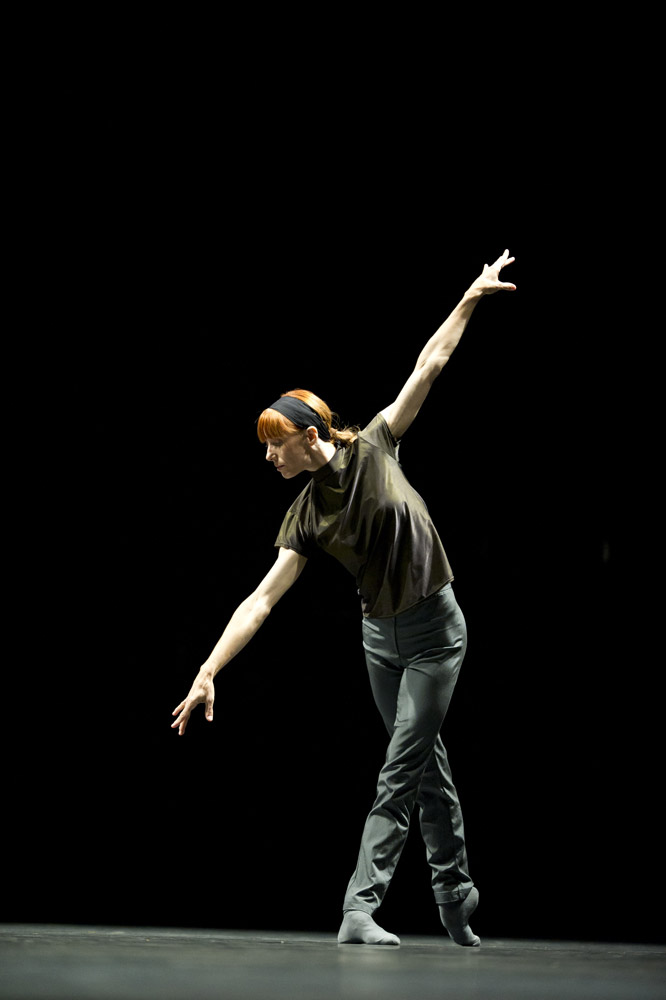
It was a bit as if Forsythe and Guillem had picked up a conversation that had been left off years earlier. This time around, though, they decided to drop the veneer of glamour (no pointe shoes, no sexy ballet attire, less posing with one leg bent to show the beauty of the calf) and just got down to business, like the two mature, no-nonsense artists that they are. Instead of stabbing the stage with her pointes – though it must be said, Guillem looks like she’s on pointe even when she’s not – she slid and glided across the stage in her socks, morphing her body into multi-faceted, fragmented poses without the slightest hint of preparation. Several times she held her leg in her signature 180-degree, ear-touching extension, on relevé, creating a palpable stir in the audience. I think Forsythe was having a laugh: yeah, she still has it. Meanwhile, the electronic score (by David Morrow) blipped and yelped in little spurts, inoffensively. Every so often, Guillem and Murru paused in a very formal, exaggerated balletic pose, fourth position or an arabesque, or, often, a simple tendu with the arms held in third position (one up, one to the side) as if to say, “voilà, this is our starting point.” Then they would set off on a new set of variations, mostly separately, sometimes alone, sometimes in a more formal “partnering” sequence where one dancer would touch or lean on or hold, or at least make some reference, to the other. There was a “sitting” sequence, in which every phrase seemed to include a moment in which the knees were bent and the torso tilted forward, as if getting up from a chair; a “ducking” sequence, in which they avoided each other’s limbs; a “leaning” sequence, in which they depended on each other for support. For the most part, each did his or her own thing. It looked as if it might be fun and engrossing to do, in the way that a puzzle is fun and interesting to put together. Or like watching chess without knowing the rules. The audience couldn’t really see their faces, but I suspect it didn’t make much difference. Guillem executed every movement with easy precision and near-total lack of inflection or emphasis. In fact, the most expressive part of her dancing, to me, was not dancing at all, but rather her slightly stiff-looking walk between segments. Maybe she’s human after all. Murru was less pristine but more playful, warmer, less even-keeled. I’d like to see more of him; he seems like a beautiful, impassioned dancer. But, for the most part, it was pretty dry.
The next piece was the Kylian, 27’52” (named after the duration of its musical accompaniment, by Dirk Haubrich). It was more gimmicky; there were industrial lights scattered around the edges of the stage, and at the start, one of the dancers, Lukas Timulak, was rolled up under a piece of floor-covering. (Both dancers ended up cocooned in floor-covering). Aurélie Cayla is a very beautiful woman, with pale skin, dark, intense eyes, wide lips; she began the piece in black trousers and a red pleated top, showing off her broad-shouldered, powerful build. She coolly delivered muscular, warrior-like poses, and then she and her partner embraced; he picked her up in various awkwardly-folded, off-kilter lifts or pulled her around by one leg. Some conflict was implied. Soon enough, she was topless, like her partner. She spent much of the second part lying on the floor, while Timulak did a solo, sliding across the stage and gesticulating with his arms, or doing multiple turns on flat feet – possible, because of the socks – with his arms bent in front of him. The choreography came across as less articulate than Forsythe’s, too focused on the upper body and not enough on the legs and feet. On the upside, there were more variations in tempo.
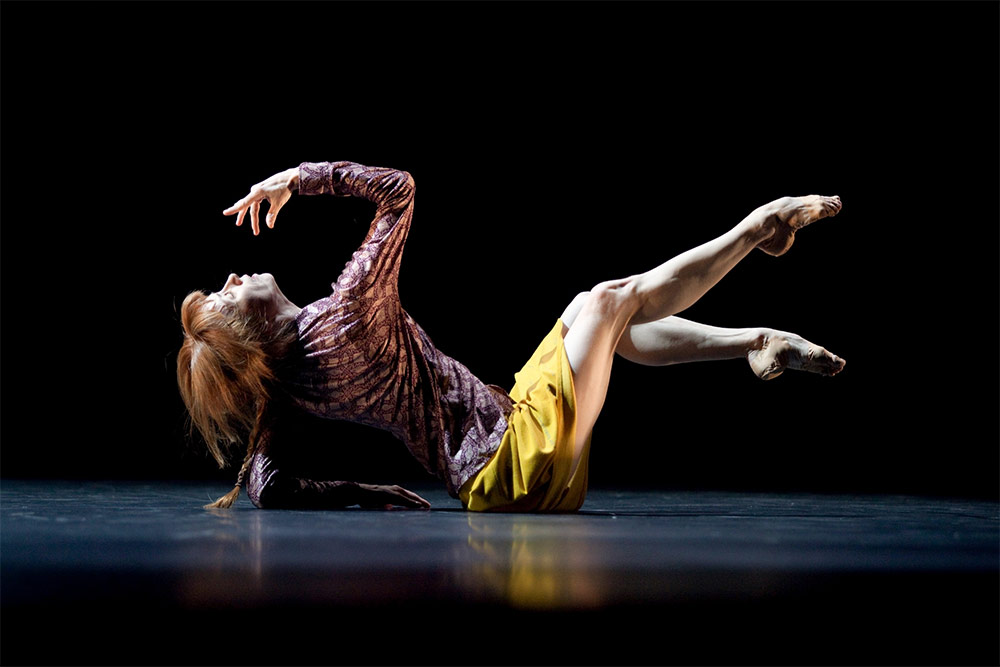
The final dance was the evening’s pièce de résistance, the most poignant work of the evening, a summing up of sorts. Mats Ek’s Bye is clearly a portrait of Guillem, an artist he has worked with often since the eighties. There is clear affection and a little corniness built into the work, in which Guillem appears wearing a dowdy yellow knee-length skirt, lace-up shoes (and socks), a button-down shirt, and a cardigan, with her hair messily drawn back in what looks like a braid. She could be any vegan-skinny housewife in Park Slope, except she’s Sylvie Guillem. The concept is clever enough: a door-like surface stands upstage left, upon which images are projected, first of Guillem’s face, and then of her body, life-size. In a nifty game of illusions, Sylvie appears and disappears into this frame; at times you’re not quite sure if it’s the real Sylvie or her double before you; sometimes, it’s both at once. Ek has chosen the beautiful arietta movement from Beethoven’s piano sonata no. 32, a theme and variations, in a recording by Ivo Pogorelich. Such soulful, complicated music inevitably lends a meditative, touching air to the dance. It’s Guillem unplugged, playing around, kicking her legs like a pendulum, creeping sideways on her tippy-toes, echoing a quick line of notes on the piano, tapping her heels, knocking on the doorframe, standing on her head, or, out of nowhere, pulling off some rather impressive leaps. Lest anyone wonder, La Guillem’s jump certainly hasn’t lost its kick, nor its marvelous sense of trajectory. If Natalia Osipova’s ballon is a natural phenomenon, Guillem’s is an act of will, a demonstration of the mechanics by which a body can contradict the laws of gravity. Late in the piece, she takes off her cardigan, shoes, and socks; finally, we get to see those marvelous insteps for which she is famous. Meanwhile, the illuminated doorway continues to reveal little bits of “everyday” life: a dog, a man in a plaid shirt. She doodles some more, and then gets dressed again. She slowly approaches the door, in which a crowd of onlookers, “regular folk” (including an old woman) now appear, as if waiting for her. She seems to step into the frame and join them, with her back to us. As the small crowd walks away from us, the projection of Guillem turns back one last time, and keeps walking, with the others. I’m not sure if it’s a farewell to the stage, but the message seems to be “goodbye to all that.”
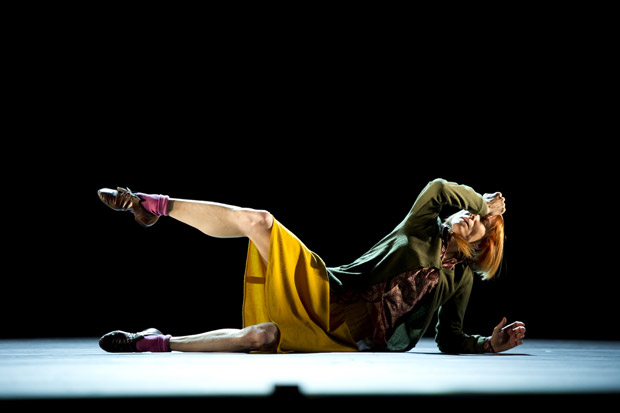
The crowd erupted in cheers. Ek’s piece hints at another side of Guillem, a goofier, simpler human being beneath the veneer of the icon. If it feels a little coy, well, maybe it is, maybe it isn’t. It’s a smart, well-calibrated program in every sense. Not too long, not too taxing, with just enough soul to send audiences happily into the night.













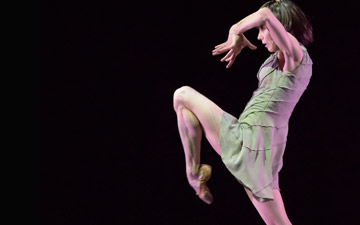
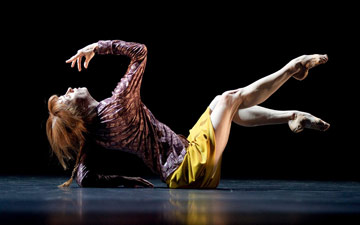
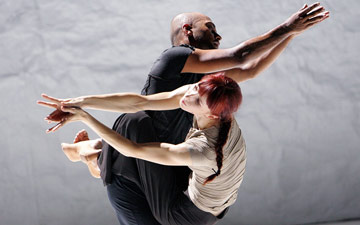
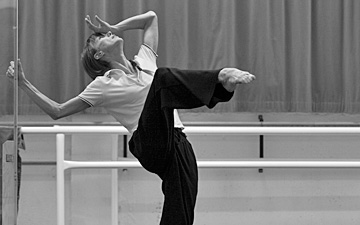
Hello
Congratulations for this wonderful, detailed and precise account of Sylvie Guillem’s appearance at the Lincloln Center in New York. Being a huge admirer of Guillem myself, I also appreciate your honesty from the beginning and the fact that you do not let your personnal preferences interfere with the appreciation of this show.
I was not there to see the show, but I have already seen it twice in Europe (I live in France). I attended its première in London last July and also saw it recently in Paris at the Theatre des Champs Elysées and found it astounding for various reasons. Among these, the wonderful contrast between the Forsythe piece, so strange, mathematical almost in its conception, and yet hypnotic if one gets into it and the emotionnal, pognant and funny “monologue” of “Bye” by Mats Ek. And of course there is Sylvie always at the peak of her powers, fearless, always exploring new paths in dancing. She also knows how to connect with an audience, to be unexpected as well, besides being a very articulated and intelligent performer.
I do not know whether you have seen her in other works live besides this one and “Push”. I was not thrilled by the latter when I saw it several years ago in Paris. But I was thrilled by most pieces I have seen with Guillem and I believe the more you see of her live the more you appreciate her, especially if one is lucky to have seen her in classical works as well (saw several of these including “Giselle”, “Sleeping Beauty”, “Romeo and Juliet”, “Manon”, “Marguerite and Armand” etc. And I was lucky to see her latest Manon in 2011 at La Scala in Milan which was a huge, higly deserved triumph.
Whereas other dancers keep doing one “Swan Lake” after another, or one “Don Quichotte” after another with easy, crowd pleasing effects, Guillem having already axcelled in these wonderful ballets, has chosen the path of diversity, of risk in her career, intelligently combining classical with modern choreographies always seeking new horizons in dancing. She may make mistakes, but one has to salute her courage and fearlessness as well as her artistic integrity.
‘… Two of the works, Forsythe’s Rearray and Mats Ek’s Bye, were made especially for Guillem for this show…’
I believe ‘Bye’ is an excerpt from Ek’s ‘Apartment’ (made for POB in 2000). It was up on youtube, maybe it’s still there.
“Apartment” is a different pice of work by Mats Ek, they are performing this work at the Paris Opera House this season.
“Bye” a solo dance was written especially for Guillem by Mats Ek as part of her latest show “Sylvie Guillem 6000 miles away”.
There is in fact an excerpt from “Apartment” which circulates on youtube and performed by Guillem and Nicolas Le Riche. They performed this piece in the spring of 2011 at the Theatre des Champs Elysees in Paris during a Gala which took place on the initiative of Sylvie Guillem for the victims of the tsunami in Japan.
I am obviously getting confused. Thanks for clearing that up, Nakis 🙂